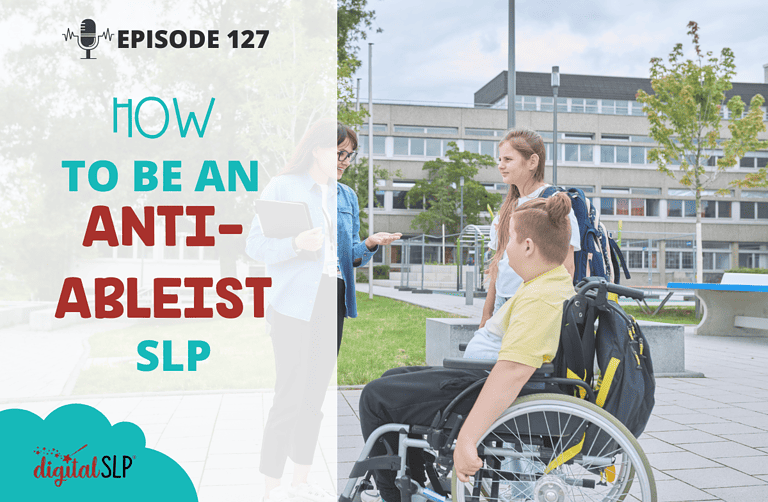In today’s podcast, we talk all about strategies and techniques for people who stutter. Specifically, I cover:
- the difference between stuttering modification techniques and fluency enhancing strategies
- a variety of techniques to use in your speech room with your students who stutter
- what I refer to as “strategy shaming”
Although there are a variety of techniques out there, the ones that I touch on in today’s episode are:
- cancellations
- pull-outs
- pseudostuttering
- light articulatory contact
- easy onsets
- stretchy speech
- reduced rate of speech
- preparatory sets
- constant phonation
Listen below to learn more and don’t forget to click here to get your FREE stuttering strategies handout where I summarize the techniques discussed in today’s podcast.
Links & Resources
Full Transcript of Podcast: Strategies and Techniques for People Who Stutter
Episode 34: Strategies and Techniques for People Who Stutter
You're listening to the Speech Space Podcast, a podcast full of tips and resources for SLPs. I'm your host, Jessica Cassity, and this is Episode 34.
Hey everyone! Thank you for joining me today to talk about some stuttering strategies. Before we get started, I just wanted to take a moment to let you guys know that this podcast is brought to you by The Digital SLP membership site, which is a site that features no-print and low-prep resources for SLPs. In addition to a growing library of videos that help to summarize evidence and provide you with information to help make your job as an SLP easier. To learn more about The Digital SLP membership, please head on over to thedigitalslp.com/digitalslp.
All right, so let's go ahead and talk about some stuttering strategies. All right. So before I get started, I just wanted to give a little disclaimer that I'm actually doing this podcast in my car. So if you hear other cars driving by, or for example, my car was just making a weird noise. Just disregard that. That might happen. There's also some birds kind of chirping in the background, so we'll see what happens. But before I jump into these strategies that I'm going to discuss today, I did wanna briefly cover the difference between stuttering modification strategies and fluency-enhancing techniques. So as the name suggests, stuttering modification teaches people who stutter to modify something in the moment that they're stuttering. So this might be by using a pull-out, cancellation, or relaxing their muscles during a moment of stuttering. And this helps the person who stutters to be able to stutter in a more relaxed way. And it also helps to increase feelings of control. Now, fluency-enhancing techniques are things that are more preventative in nature, and they're really more like strategies for promoting fluency versus repairing a disfluency like we do when we're using stuttering modification techniques. Some examples of fluency-enhancing techniques are things like easy onsets, reduce rate of speech, and light [articulatory] contacts.
All right. So now that we have covered the basics, let's go ahead and talk about some strategies and techniques. First up is cancellations. Now, cancellations can be thought of as giving yourself a redo. So after stuttering on a particular word, you're going to stop and try to say the word again fluently, but just in a more controlled manner. So it's important to remember that with this technique, you're going to finish the word before you start over. So if you're using this technique and say you're stuttering on the word "ball," it might sound something like this, "Throw the b-b-b-ball... ball to me."
All right. So next step is pull-outs. Now, when using pull-outs, you're going to ease out of the stutter rather than trying to push through. So essentially you're going to be saying the same thing, but just in an easier and more controlled manner. The difference between the pullout and cancellation though, is that with the cancellation, we repeated the words. So we kind of pushed through there and then we did our redo. But with the pull-out, you're actually not going to say the word again. So I'm gonna show an example to try to clarify what I'm trying to explain here. So say you were again, stuttering on the word "ball" and you were repeating the /b/ sound. So using a pull-out might sound something like this, "Throw the b-b-b-ball to me." Okay. So we kind of eased out of that sound repetition and relaxed into the word "ball."
All right, next up is light articulatory contact. Now, for this strategy sounds are produced in an easy manner with the least amount of pressure or tension. So, for example, when you press your lips together to make the sound /ba/, there is a buildup in pressure. Now, instead of pressing your lips together so tightly, we relax them and lightly press them together to make the same sound. So when producing sounds with light articulatory contact, the goal is essentially to minimize tension and pressure.
Easy onsets are another strategy. And when using the easy onset technique, you exhale slightly while producing the first sound of the word that you're saying. So you can think of this as making a slight "hhhh" sound like, almost like an exhale before you begin to speak.
Stretchy speech is another technique that most of us have heard of. And when using stretchy speech, sounds are prolonged or stretched out beyond their normal duration. So, for an example, say we're saying the word "apple," it might be produced like "aaaapple."
Reduced rate of speech is another technique. And for this strategy, the normal rate of speech is just slowed down. So by doing this, proper breathing and relaxed speech muscles are more likely. This also provides extra time to think about using specific speech strategies and pausing after every few words can be a helpful way to remember to slow down the rate of speech.
Pseudostuttering is another method that we might use in speech therapy. And that is just a fancy word for intentional stuttering. So this can be helpful for practicing certain fluency modification techniques like cancellations or pull-outs, and for purposes of desensitization. In order to gain perspective, it's often helpful for friends or family members to also practice this technique. So they can kind of get an idea of what it feels like to be a person who stutters for a few minutes or for a day. You know, it really helps them to gain some added perspective into the life of a person who stutters.
Preparatory sets can also be used, and these occur before a stutter actually occurs. The person who stutters anticipates that they will have difficulty with an upcoming sound or word, and they produce that word in an easier, more controlled manner instead. For example, if there's a person who stutters and they have difficulty with the letter B, then before they say a word that starts with the letter B, they would focus on relaxing their lips and making that sound with the least amount of tension possible. So it's kind of what they do in preparation for an upcoming sound that they know is generally troublesome.
Now, while there are many other techniques out there, the last one that I'm going to share with you today is called constant phonation. And when using this technique, focus is kept on keeping the voice turn on for the duration of a phrase or sentence. When using this technique properly, it can sound robot-like. So this obviously is not a long-term goal kind of technique. But the reason for this is because you're continuously speaking rather than pausing in a natural way between words. Now, remember that just because you're not pausing does not mean that you should rush through. It's still important when using this strategy for our students or clients who stutter to keep their rate of speech slow and steady.
Okay. So before I wrap up today, two things: one is that I do have a handout for you guys that summarizes these techniques mentioned in the episode. I will give you that link in just a second. There's just one thing I wanna touch on really quickly. I just wanted to remind everyone out there listening, just to be sensitive to our students and clients who stutter and to see what their specific goals are because not every person who stutters wants to change it. And that's really okay if it's something that doesn't bother them or affect their quality of life. Now, I like to think of stuttering as more of a communication variation rather than a communication disorder. I'd love to hear what you all think about that. I also wanted to just briefly mention that we also wanna make sure that we're not doing what I'm gonna refer to as "strategy-shaming," which is really just because I don't have a better way of describing it. And like I said, I totally just made that term up, but it's the best way I can describe it. It's when little Johnny is working his tail off in speech therapy, and then he's talking to a friend in the hallway or playing an unstructured game. And a well-meaning teacher, an SLP, or a parent, you know, kind of gives him a look and says, "Johnny, use your strategies." You know, we need to remember that there's a time and a place for strategy-use. And it's really okay if a person who stutters needs to take a break from using those strategies. I know we're kind of conditioned to always be encouraging fluency. And while that might be important, like I said, there is a time and a place. So I just wanted to throw that out there. I feel like that's something that's not always talked about so much. So I did just wanna briefly touch on it. And again, I would love to hear your thoughts on that. Like I mentioned, a couple minutes ago, I did create a cheat sheet to help you remember some of the most common stuttering modification strategies and fluency-enhancing techniques. And if you would like to grab that, you can do that at bit.ly/stutteringstrategies. So just make sure once you get to that page, that you do scroll down and you look in the links and resources section and the link to that will be right there for you.
All right. Well, I hope that you all enjoyed listening to today's show, and I hope that you found the review of these techniques to be helpful. If you found this episode to be helpful. Please take a second to give a five-star review on iTunes, just to help your fellow SLPs find this show. All right. That is it for me today. And I hope that you guys have a great rest of your week.













Recent Comments